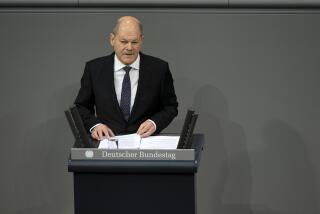Firms See High-Wage Germany in a New Light
- Share via
WIESBADEN, Germany — They’re still talking about it. The roof-raising ceremony for Motorola’s new $110-million cellular-telephone factory in Germany a few months back was one of a kind.
“The sound systems were two stories tall. They were going till 5 in the morning,” said Motorola country manager Norbert Quinkert, his pride at the successful bash mingled with a touch of mortification at the volume of the hooting and hollering.
Motorola’s German subsidiary is definitely a company with something to celebrate: Not only is it building a big, new worker-friendly factory, complete with day-care center and health club, but its revenue is also up this year and profit has nearly tripled over the 1996 figure.
“There is obviously demand for our products,” Quinkert said. “Telecommunications are en vogue.”
But how typical is Motorola with its big investment in Germany? Isn’t this the land of the fading economic miracle? The place where consumer demand is flat on its back, and where no one can agree on how to bring down unemployment hovering near the double digits? Is Motorola crazy to bet on Germany?
Not according to Quinkert, or any of the other businesspeople still finding ways to make money in this country. They say they smell change in the wind.
Indeed, the German economy is now growing at a respectable rate, and the growth is expected to withstand the aftershocks still expected from the Asian financial crisis. Domestic demand remains stagnant, but exports are booming for the second year running. Unemployment, though still painfully high, has dipped slightly for two consecutive months. In March, the seasonally unadjusted rate even declined in the former East Germany, which has lagged the country at large.
Most remarkable of all amid the pervasive gloom, there is a trickle of firms such as Motorola--faced with decisions on where to invest--that have chosen high-wage, high-regulation Germany. A few German companies are even bringing their offshore production lines home.
Sure, Quinkert said, German manufacturing labor costs may be the highest in the world--more than $31 an hour, or nearly twice the U.S. figure--and people here may regularly disappear for the world’s longest vacations and sick leaves. You can’t lay off thousands here in one fell swoop.
*
But companies such as Motorola are finding ways of getting around those notorious German obstacles, Quinkert said. He insists it’s just a matter of time before other multinationals start noticing the benefits of a German plant location and start hiring German workers, too.
“You Americans do not have a straight view on Germany over a long period of time,” he criticizes. “It’s either ‘Germany is rejuvenating’ or ‘Germany is depressed.’ But neither of these extremes is true.”
Consider Varta, a big German maker of batteries. Until last year, it was making its small, rechargeable “button-cell” batteries at a big plant in Singapore, a city-state known for its disciplined work force and other competitive strengths. That plant had seven production lines and employed about 500 people.
But in 1995--way too early to be influenced by the current Asian financial upheavals--Varta decided to move its button-cell operation back home to Germany. Here, according to board member Wout van der Kooij, Varta has been able to set up far more modern machinery and, beginning this year, is able to produce 50% more batteries than in Singapore in a tenth the space. Only 70 Germans will be needed to run the plant.
“If you need to pay only 70 people, then the high wage cost of Germany is not relevant anymore,” Van der Kooij said.
What is relevant, he said, is Germany’s technological infrastructure: the host of skilled electrochemical engineers and related technicians available on the job market. Electrochemists are virtually nonexistent in Southeast Asia, Van der Kooij said. But with their abundance here in Germany, Varta could install its state-of-the-art equipment, confident of maintaining it, repairing it and buying needed supplies without ever leaving the company’s own backyard.
“In Singapore, we wouldn’t have been able to get the technology together,” Van der Kooij said.
At Motorola, Quinkert also praised Germany’s ranks of qualified workers, even at the blue-collar level.
“Everybody, before we hire him, has to pass a math test,” he said. “We don’t hire any dumb 18-year-old off the street.”
Because the German working class tends to be so well-educated, Quinkert said, Motorola’s existing cell-phone factory here has higher productivity than the company’s other such plants in China, Scotland and Illinois.
*
The only bad mark Motorola’s German plant gets, he said, is for its high direct labor costs--but labor accounts for only 2% of the total cost of manufacturing a cellular phone.
“The high [German] productivity makes much more of a difference than the low labor costs in China,” he said.
Germany’s boosters tick off the names of numerous other companies--all of them in non-labor-intensive, high-technology fields--that are repatriating production lines from the Far East and investing in Germany.
Motorola itself recently entered a $700-million joint research-and-development venture with the German engineering giant Siemens, in hopes of spawning a new generation of semiconductor components in the eastern city of Dresden.
*
But for all their contrarian bullishness, German high-tech managers warn against reading too much into the investment choices of their own companies.
“We are a white crow,” said Quinkert, using a Germanism for an anomaly. “Telecommunications are in full swing. You cannot compare this to a mature industry.”
That underscores the paradoxes of the German economy today: There is indeed growth, but it isn’t the sort of growth that leads to new jobs. Investors are investing, but mainly in modern labor-saving equipment, not new employees.
The export sector is flourishing, but mainly because the mark has softened--making German products cheaper overseas--and German manufacturers have honed their product lines and “rationalized” their production processes to whittle costs.
Meanwhile, about 12% of the work force is officially unemployed and domestic demand is not growing at all.
These contrasts have given rise to a potent debate this year over the relationship between consumer spending and wage policy and how best to create new jobs.
The same discussion is going on in France, Italy and other high-unemployment Western European countries. But it is particularly pointed in Germany this year because there will be a federal election in September. Chancellor Helmut Kohl’s main opponents-- the Social Democrats--hope to oust the well-entrenched incumbent on the issue of joblessness.
The Social Democrats argue that their economic medicine would lead to both growth and jobs, if only they are allowed to form the next government. They say they would push for higher wages and that before long German consumers would find more money jingling in their pockets. That, in turn, would lead to a much-needed increase in domestic demand. The economy would be buoyed, factories would have to step up production and soon they would hire more people.
But this familiar European scheme horrifies other analysts here who argue, just as forcefully, that Germany will see more jobs only if it reduces wages, not increases them.
“For two years, we’ve had moderate wage increases,” said Ulrich Schroeder, head of economic and banking policy at Deutsche Bank. “This is positive and helpful. If this were maintained for at least 10 years, then we would get results.” If wage restraint is abandoned, he predicts, “we will never reach full employment.”
Though the German business class has complained long and loud about Kohl’s economic management, the new threat this year from the Social Democrats is making them reconsider the chancellor.
Although the current dip in unemployment may be in part the result of election-year tinkering--the Kohl government launched some subsidized job-creation schemes in January--Deutsche Bank’s Schroeder said a significant portion of today’s economic growth can be traced to some seemingly timid wage-reform policies that Kohl pushed through the Bundestag in 1996, under the slogan “Alliance for Jobs.”
*
Back then, growth was still stalled, unemployment was rising and businesspeople were railing about the high cost of the welfare state. The Alliance for Jobs was supposed to address this with various programs to reduce costs to industry. Mandatory pension contribution levels would be eased. Small companies would have greater freedom to let workers go.
Kohl predicted that if these and other pieces of the new, pro-business regimen were put into place, unemployment would be cut in half by 2000.
A central element of the Alliance for Jobs strategy was to be the reduction of legal sick pay in Germany. Today, employers must pay 100% of a worker’s wages when he or she is sick--no matter how often or for how long. Kohl’s proposal was to reduce this to 80% for the first six weeks of an illness.
The justification: Statistics show that full sick pay has encouraged a pervasive culture of cheating and absenteeism. But full sick pay is perhaps the single most important victory won by organized labor in the postwar period, and unions were not about to let it be rolled back. When a few early-bird companies announced they were going to take advantage of Kohl’s “reform” by reducing sick pay, workers staged wildcat strikes.
The companies quickly backed down, and that appeared to be the end of the Alliance for Jobs.
But behind the scenes, Schroeder said, industrialists have been able to use the new sick-pay policy to wring other valuable concessions out of workers. Again and again since 1996, managements have told their employees that they could keep on getting 100% sick-pay benefits, but they would have to give up something else in exchange.
And work forces have done it, accepting everything from overtime at no extra pay to cost-saving “flex-time” work schedules. Heretical as these givebacks may be by traditional union standards, they have helped unions save face by keeping 100% sick pay intact.
The upshot: Work forces have become more flexible, labor unrest has been held to a minimum and German companies have saved a great deal of money. Varta’s Van der Kooij, for one, said that his German workers have agreed to work more hours at no extra pay, in effect taking a 7.5% pay cut.
*
Deutsche Bank economist Schroeder cited one recent study estimating the total savings to German industry at about $4 billion.
“These are durable savings, and they are definitely giving companies a big lift,” he said.
Schroeder’s fear now is that the respectable 2.5% growth projected for this year will embolden unions to demand heftier paychecks.
“This is the big problem with Germany,” he said. “When the worst times are over, the unions come back and ask for more wage increases, and they will probably get them. Our core problem is our wages, but we lack the honesty to admit this.”
(BEGIN TEXT OF INFOBOX / INFOGRAPHIC)
Unemployment Dip
German unemployment dropped in January in January for the first time in 16 months and continued its decline in February. Monthly unemployment rates:
January 1995: 8.1%
February 1998: 9.7%
Source: Dataquest
Researched by JENNIFER OLDHAM / Los Angeles Times
More to Read
Inside the business of entertainment
The Wide Shot brings you news, analysis and insights on everything from streaming wars to production — and what it all means for the future.
You may occasionally receive promotional content from the Los Angeles Times.










